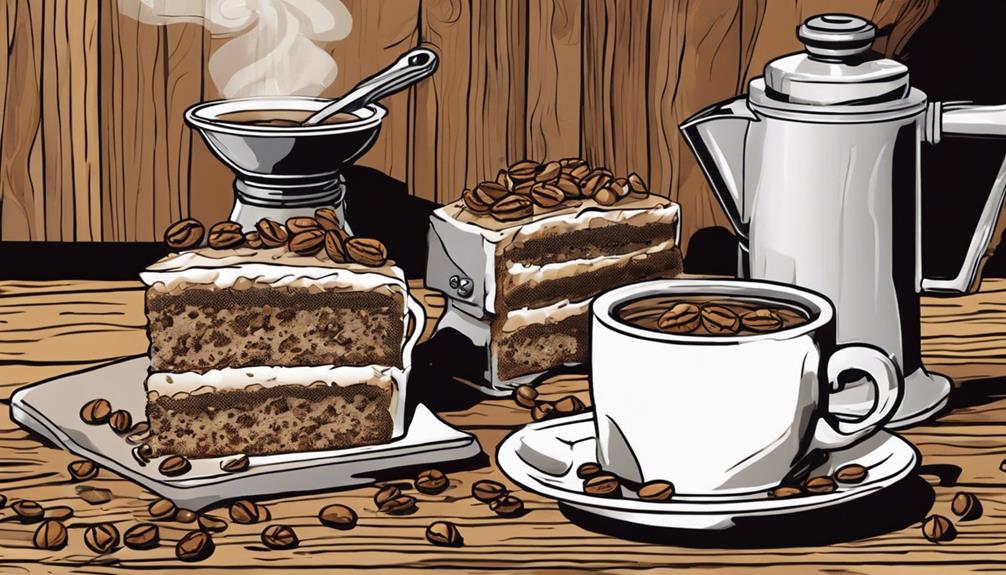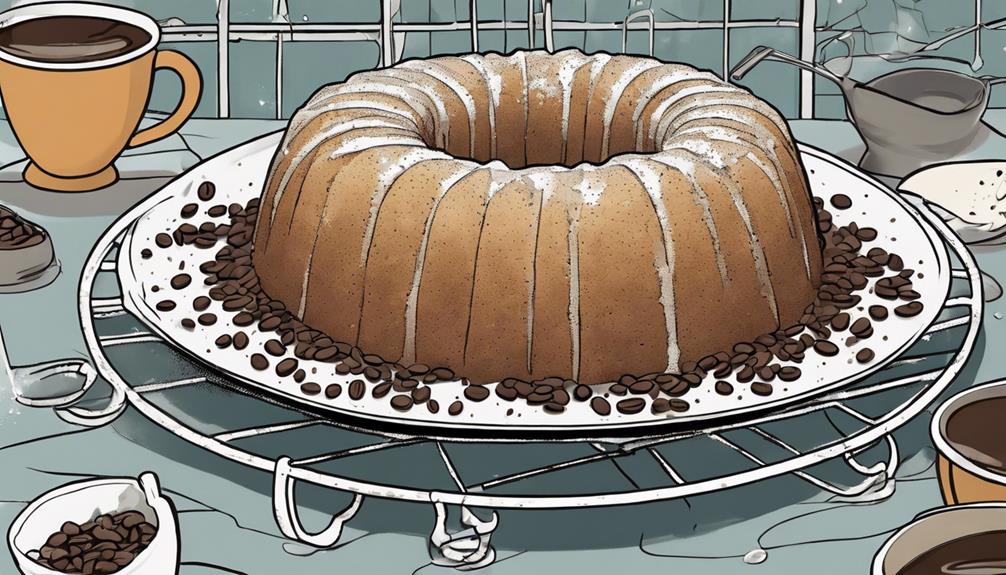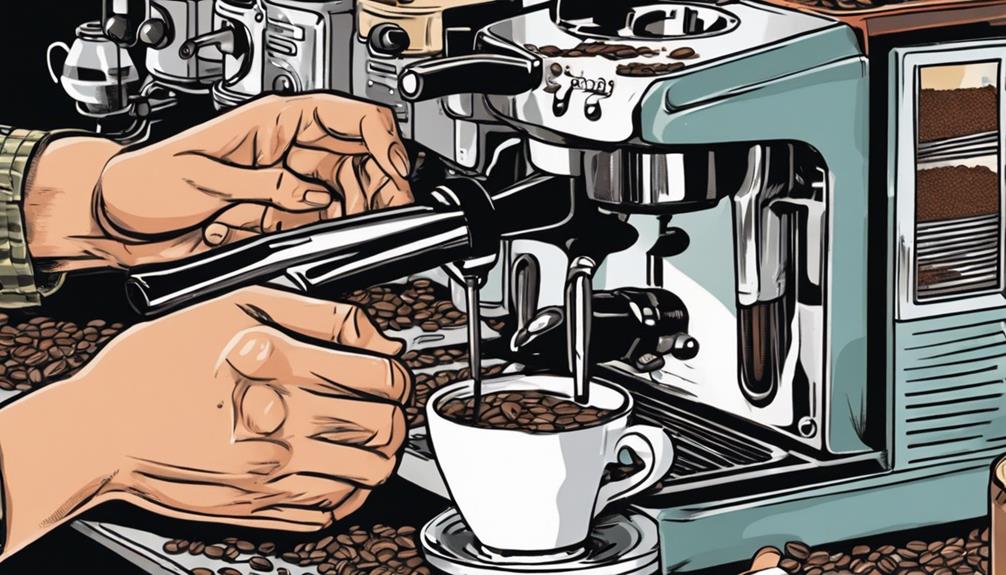To make a delicious coffee and walnut cake, start by creaming together butter and sugar, then adding eggs, flour, coffee, and walnuts. Bake at 180°F for 20-25 minutes. Elevate the buttercream frosting with espresso and try out different kinds of toasted nuts. Ground walnuts can add a unique texture and flavor. Achieving a perfect balance of flavors with espresso and vanilla essence is crucial. To achieve a smooth buttercream, soften butter and mix in dissolved espresso powder. Garnish with walnut halves, crushed walnuts, and cocoa powder for a visually appealing finish. Enjoy the cake fresh for the best flavor. Mastering this recipe will undoubtedly improve your baking skills.
Key Takeaways
- Incorporate ground walnuts for a nutty crunch in the cake batter.
- Enhance flavor with 3 tbsp of instant coffee in both cake and buttercream.
- Use espresso buttercream for a bold coffee taste.
- Decorate with walnut halves and crushed walnuts for visual appeal.
- Serve freshly baked or within 3 days for optimal freshness.
Cake Preparation
To prepare the cake, cream together softened butter and sugar for a light and fluffy texture.
Next, add in eggs, flour, instant coffee, and chopped walnuts to create a flavorful and textured batter. Make certain to mix everything well until it's smooth and well-combined.
Divide this aromatic mixture evenly between two greased and floured round baking tins. This step ensures that your cakes bake evenly and are perfect for layering later on.
Pop the tins into the oven preheated to 180°C and bake for 20-25 minutes, or until a skewer inserted into the center comes out clean.
Once baked, allow the cakes to cool completely before generously spreading the espresso buttercream between the layers and on top.
This rich and decadent icing will complement the coffee and walnut flavors beautifully, creating a truly indulgent treat for all coffee lovers out there.
Flavor Enhancements
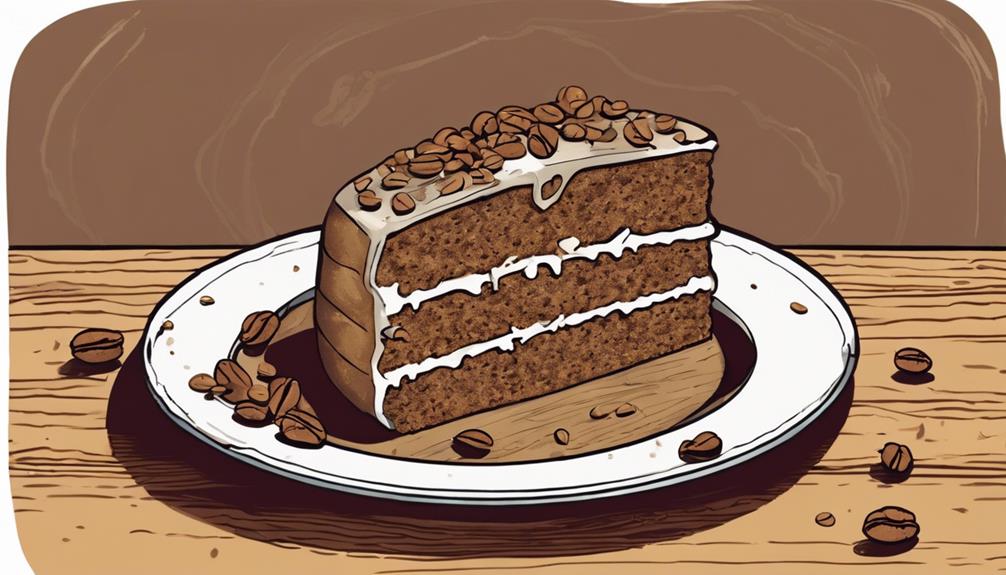
To enhance the coffee flavor of your cake, consider adding a bit of espresso to the buttercream.
Experiment with toasting the chopped nuts before incorporating them into the batter for a richer taste experience.
Balancing the sweetness of the buttercream with the boldness of the coffee creates a harmonious flavor profile in your coffee and walnut cake.
Enhancing Coffee Flavor
Enhancing the coffee flavor in your cake can be achieved by incorporating 3 tbsp of instant coffee for a bold taste.
To keep things interesting, consider the following tips to enhance the flavor of your coffee and walnut cake:
- Experiment with ground walnuts in the batter for a unique texture and flavor profile.
- Toast chopped nuts before adding them to the cake to intensify the nutty taste.
- Add optional flavorings like vanilla essence or rum to complement the coffee flavor beautifully.
- Consider using soft brown sugar in the recipe to enhance moistness and depth of flavor.
- Don't forget to sprinkle some extra chopped walnuts on top for a delightful crunch.
Textural Walnut Addition
Consider incorporating ground walnuts into the batter of your coffee and walnut cake for a unique textural enhancement and added nutty flavor. Ground walnuts provide a delightful crunch and nutty essence to the cake, creating a harmonious combination of textures and flavors.
When toasted before adding to the batter, the chopped walnuts release a heightened flavor and aromatic profile, enriching the overall taste experience.
The addition of walnuts not only contributes to a distinct flavor but also plays an essential role in the cake's texture. The ground walnuts result in an ultra-light and fluffy consistency, while walnut pieces within the batter offer a satisfying contrast to the soft crumb of the sponge.
This contrast in textures, between the crunchy walnuts and the tender cake, elevates each bite, creating a delightful sensation for your taste buds.
Icing Flavor Balance
For an irresistible finishing touch to your coffee and walnut cake, infuse your icing with complementary flavors that enhance the overall taste experience.
Here are five ways to achieve the perfect icing flavor balance:
- Incorporate ground walnuts into the icing for a unique texture that complements the cake.
- Use soft brown sugar in your icing recipe to maintain a moist and delicious consistency.
- Experiment with flavorings like vanilla essence or rum to add depth and richness to the icing.
- Toast chopped nuts before adding them to the icing to enhance their flavor and crunchiness.
- Amp up the coffee notes by adding 3 tbsp of instant coffee to the icing, creating a bold and flavorful contrast.
Icing Options

You have various options when it comes to icing your coffee and walnut cake. Experiment with Nigella Lawson's classic buttercream or try Delia Smith's coffee mousseline for a French twist.
Enhance the flavor profile by dissolving coffee granules in the icing or adding rum, double cream, or mascarpone for extra richness.
Buttercream Variations
Explore different buttercream variations to elevate the flavor of your coffee and walnut cake. When it comes to icing options, there are several delicious choices to explore:
- Nigella Lawson's classic buttercream offers a timeless and crowd-pleasing option for your coffee and walnut cake.
- Delia Smith's suggestion of using coffee mousseline provides a French buttercream twist that adds sophistication to the dessert.
- Ree Drummond's cream-based icing is a simple and easy-to-spread option that complements the flavors of the cake.
- For a richer flavor profile, contemplate incorporating rum, double cream, or mascarpone into your buttercream.
- While there are many icing options available, buttercream remains a top choice due to its versatility and ability to enhance the coffee and walnut cake's taste.
Experiment with different variations to find the perfect match for your baking creation.
Icing Flavor Enhancements
Consider incorporating various flavors and ingredients into your icing to enhance the overall taste of your coffee and walnut cake. When choosing the perfect icing for your cake, you have a variety of options to elevate the flavor profile. Here are some popular icing flavors and enhancements recommended by renowned chefs like Nigella Lawson, Delia Smith, and Ree Drummond:
| Icing Flavors | Recommended Chefs | Unique Twist |
|---|---|---|
| Buttercream | Nigella Lawson | Classic choice |
| Coffee Icing | Delia Smith | French buttercream twist |
| Cream-Based Icing | Ree Drummond | Easy to spread |
| Rum Flavor | Various Chefs | Unique touch |
| Mascarpone | Various Chefs | Creamy addition |
Baking Instructions
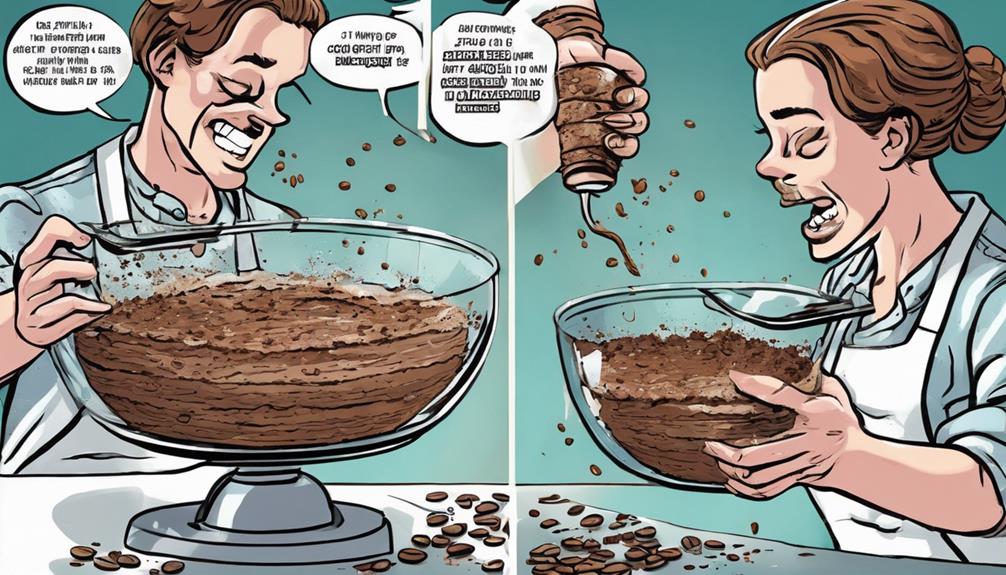
To achieve a light and fluffy texture for your coffee and walnut cake, start by preheating the oven to 180°C and preparing two round baking tins with grease and flour.
Here are some key steps to guide you through the baking process:
- Cream softened butter and sugar until airy and fluffy for a perfect sponge cake texture.
- Incorporate eggs, self-rising flour, instant coffee, baking powder, and chopped walnuts for a flavorful coffee sponge.
- Divide the batter evenly between the prepared round cake tins for even baking.
- Bake the cakes at 180°C for 20-25 minutes until they're risen, golden, and a skewer comes out clean.
- Allow the cakes to cool completely before assembling.
Following these instructions will guarantee your coffee and walnut cake turns out moist, delicious, and full of rich coffee flavor.
Recipe Specifics
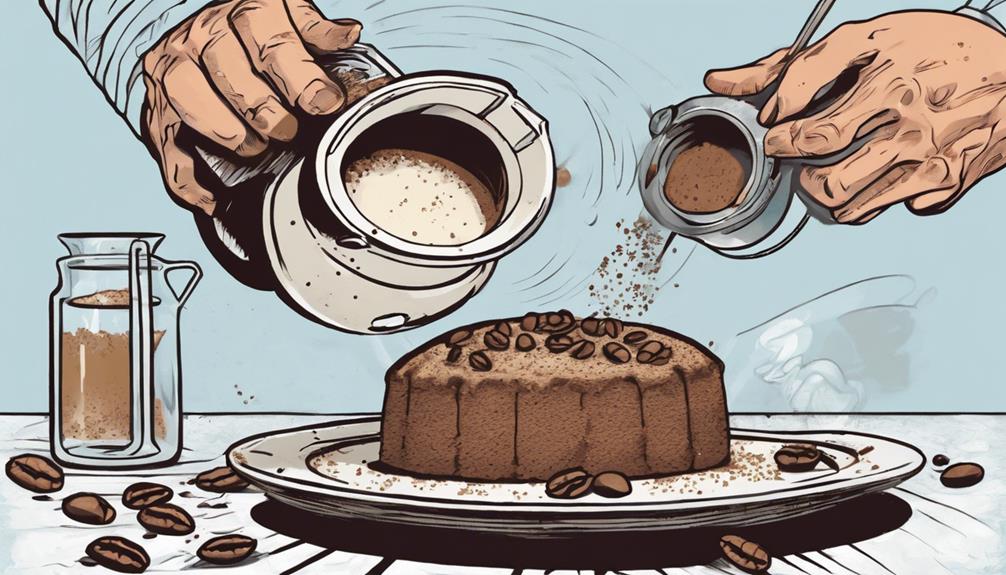
When focusing on the recipe specifics for baking your coffee and walnut cake, using two round baking tins is essential for best results. The two tins guarantee that the cake bakes evenly and allows for the creation of uniform layers, which are necessary for a visually appealing Victoria sponge. By distributing the batter evenly between the two tins, you ensure that the cake will rise consistently, resulting in a balanced texture and taste.
Before pouring the batter into the tins, make sure to grease and flour them adequately. This step is vital for easy release of the cakes once baked and guarantees that the layers remain intact. Additionally, using two tins rather than one will impact the baking time, as the cakes will bake more quickly and evenly.
To enhance the appearance and flavor of your coffee cake, consider decorating the top with walnut halves before baking. This not only adds a delightful crunch but also enhances the overall presentation of the cake.
Buttercream Preparation

Dissolve espresso powder in water to infuse the buttercream with a rich coffee flavor that will complement the coffee and walnut cake perfectly.
To prepare the buttercream, follow these steps:
- Soften the butter until it reaches room temperature for easy creaming.
- Cream the softened butter with icing sugar until you achieve a smooth and creamy texture.
- Incorporate the dissolved espresso powder into the buttercream mixture.
- Mix the coffee-infused buttercream until the flavors are fully combined.
- Use the espresso buttercream as both the filling and topping for the cake to enhance the walnut theme.
Decorating Tips
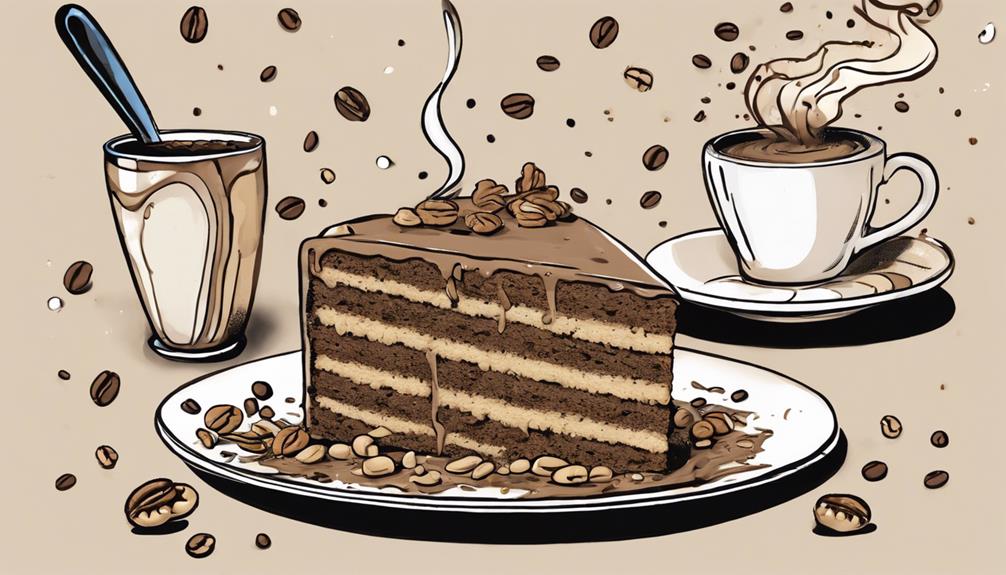
Looking to add a touch of elegance to your coffee and walnut cake? Here are some decorating tips to elevate the presentation of your delicious creation:
| Decorating Tip | Description |
|---|---|
| Walnut Halves | Place walnut halves on top of the cake for a classic and sophisticated finish. |
| Buttercream Piping | Use buttercream to pipe around the edges of the cake for a polished and professional appearance. |
| Crushed Walnuts | Sprinkle crushed walnuts over the top of the cake to add both texture and visual appeal. |
| Decorative Patterns | Create decorative patterns on the sides of the cake using a cake comb or spatula with buttercream. |
To give your coffee and walnut cake a final sophisticated touch, lightly dust the finished masterpiece with either cocoa powder or coffee grounds. By incorporating these decorating tips, you can guarantee that your cake not only tastes delightful but also looks visually stunning.
Serving and Storage
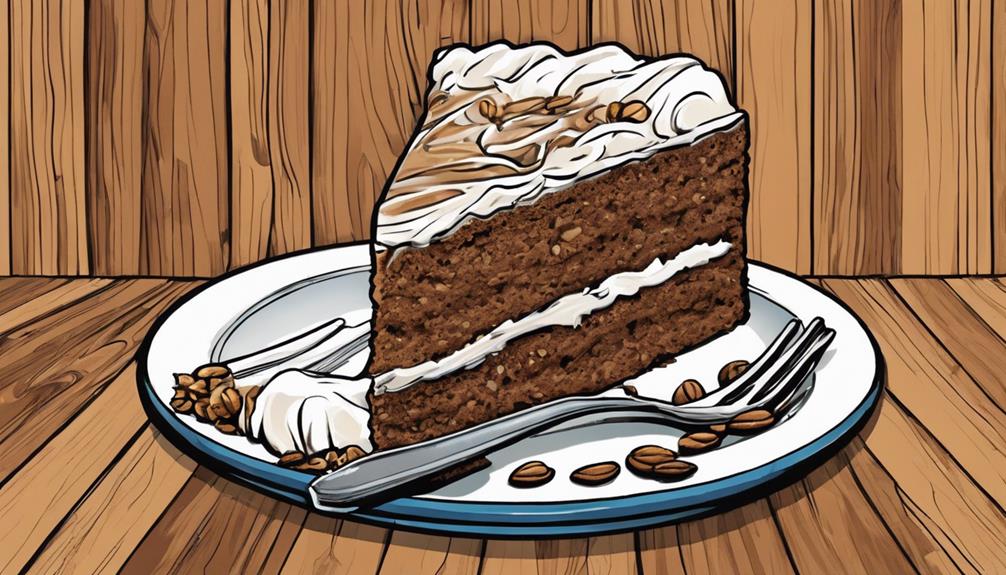
For peak freshness and taste, serve the coffee and walnut cake on the day it's baked or the day after for the finest experience.
To maximize your enjoyment of every bite, consider the following tips:
- Assemble the cake with indulgent buttercream layers for a rich and creamy texture.
- Decorate with walnut pieces and crushed walnuts for a visually appealing presentation.
- Store covered at room temperature for up to 3 days to maintain peak freshness.
- Preserving the cake's texture helps retain the bittersweet combination of flavors.
- Savor the satisfying crunch of walnuts by enjoying the cake within the suggested storage timeframe.
Frequently Asked Questions
What Pairs Well With Coffee Cake?
When enjoying coffee cake, pair it with a hot cup of coffee or tea for a delightful caffeine boost. Complement its rich flavors with freshly whipped cream or a scoop of vanilla ice cream.
How Long Can You Keep a Coffee and Walnut Cake?
You can keep a coffee and walnut cake covered at room temperature for up to 3 days. For longer storage, refrigerate it for a week. To extend shelf life, use an airtight container in the fridge.
What Does Adding Coffee to Cake Mix Do?
Adding coffee to cake mix enhances the flavor and texture, creating a rich and moist crumb. It introduces a hint of bitterness, activates baking powder for a better rise, intensifies chocolate notes, and conveniently infuses flavor without extra liquid.
What Temperature Should Coffee Cake Be Cooked To?
To cook coffee cake perfectly, bake it to an internal temperature of 210°F, ensuring a moist texture at 350°F for 30-35 minutes. Test doneness by inserting a toothpick; it should come out clean or with a few moist crumbs.
Conclusion
So, next time you're in the mood for a delicious and classic dessert, don't hesitate to try baking a coffee and walnut cake! There’s nothing quite like the rich and comforting flavor of coffee paired with the nuttiness of walnuts. Baking a coffee cake is a great way to satisfy your sweet tooth and impress your friends and family with a timeless treat. Whether you enjoy it with a cup of coffee in the morning or as an after-dinner indulgence, a coffee and walnut cake is sure to become a new favorite in your dessert repertoire.
Remember, even if you're not a seasoned baker, this recipe is simple and easy to follow.
Plus, the rich coffee flavor perfectly complements the nutty walnuts for a truly irresistible treat.
Give it a shot and impress your friends and family with this delectable pairing!
